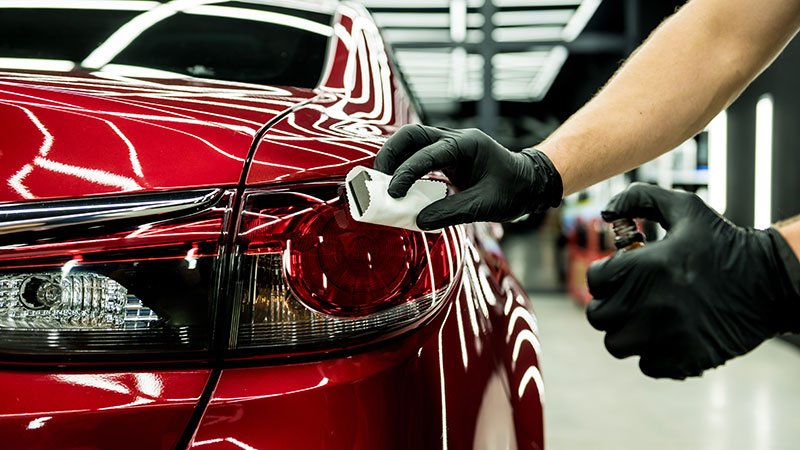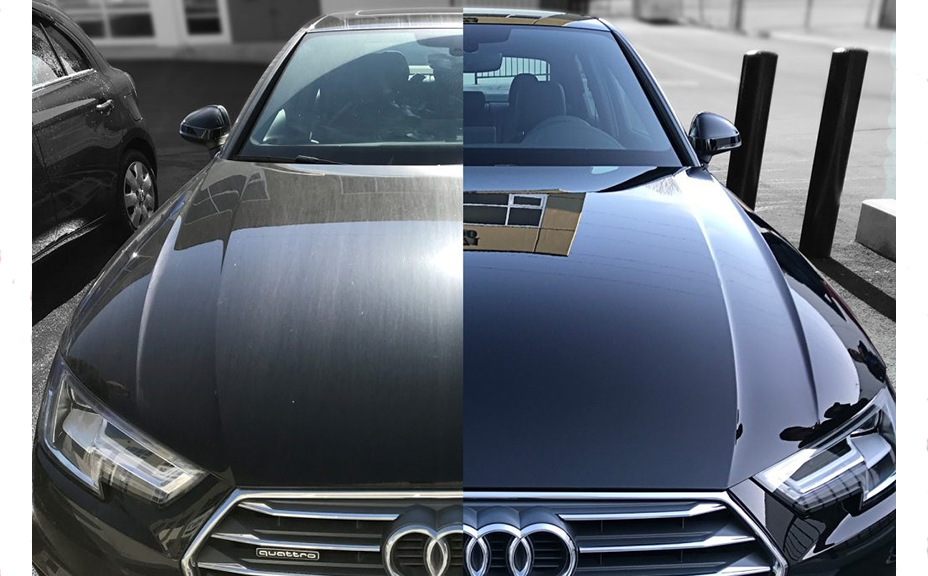Exploring the Science Behind Car Ceramic Coating and Its Protective Features
The scientific research of car ceramic coating offers an interesting study in advanced auto security. Made up mainly of silicon dioxide and polymers, these finishings develop a durable bond with vehicle paint. This interaction improves longevity against ecological dangers while supplying hydrophobic advantages. However, the intricacies of exactly how these coverings work and their long-lasting benefits stay less comprehended. Unpacking these details discloses why ceramic finishes are coming to be a preferred selection for automobile care
What Is Ceramic Coating?
Ceramic coating is a fluid polymer that chemically bonds to the surface of an automobile's paint. This advanced safety layer enhances durability and supplies premium resistance to environmental variables. Unlike traditional wax or sealants, which supply short-term security, ceramic coverings develop a lasting guard that can endure harsh conditions such as UV rays, acidic pollutants, and extreme weather. When used properly, the coating forms a hydrophobic surface area, triggering water to bead and slide off, which aids in keeping the lorry's sanitation. Furthermore, it supplies enhanced gloss and deepness to the paint, making the lorry appear more sleek and vibrant. The application process commonly includes extensive surface area preparation, including cleaning and polishing, to ensure peak bonding. As a result, ceramic layers are coming to be progressively preferred among car enthusiasts and those looking for to safeguard their financial investments, guaranteeing to preserve the automobile's visual charm while lowering the regularity of maintenance.
The Structure of Ceramic Coatings
The elaborate formula of ceramic coverings mostly consists of silicon dioxide (SiO2), which is obtained from all-natural resources like quartz and sand. This vital part supplies the foundation for the coating's resilience and safety qualities. Along with SiO2, ceramic finishes commonly consist of numerous polymers and ingredients that enhance adhesion, versatility, and resistance to environmental elements. These compounds function synergistically to produce a durable obstacle against impurities such as dirt, chemicals, and UV rays.Furthermore, some solutions include titanium dioxide (TiO2) or various other nanomaterials, which can increase the coating's hydrophobic residential properties, resulting in improved water repellency. The specific structure can differ greatly amongst manufacturers, affecting performance and durability. Inevitably, the combination of these elements finishes in a safety layer that not only improves the visual charm of automobiles yet additionally offers to lengthen their life-span by protecting the surface from potential damage.
How Ceramic Coatings Job
Understanding how ceramic layers function involves exploring their chemical make-up, which contributes to their safety top qualities. The application process is important for attaining optimal outcomes, while longevity and durability factors establish the coating's performance in time. Together, these aspects highlight the advantages and efficiency of ceramic layers for car defense.
Chemical Composition Explained
While lots of car proprietors seek resilient protection for their lorries, the chemical composition of ceramic coverings plays an important role in their performance. These finishes mostly contain silicon dioxide (SiO2), which is originated from natural minerals. This compound creates a strong bond with the vehicle's paint, creating a sturdy, safety layer. Additionally, numerous ceramic layers have titanium dioxide (TiO2), enhancing their hydrophobic residential or commercial properties and resistance to UV rays. The existence of polysiloxanes can additionally enhance flexibility and longevity. With each other, these aspects contribute to the coating's capability to repel water, dirt, and pollutants, while also giving a high-gloss finish. Recognizing this chemical structure helps car proprietors value the robust defense provided by ceramic coverings.
Application Refine Review
Using ceramic coverings involves a meticulous procedure that guarantees ideal bonding and security for the lorry's surface area. Complete cleaning and decontamination of the car's exterior are done to get rid of dirt, crud, and previous waxes. This step verifies that the surface is without contaminations that can impede attachment. Following this, the paint is commonly brightened to boost quality and get rid of any type of imperfections. Once prepared, the ceramic coating is applied in little areas using an applicator pad, permitting for uniform coverage. The coating is then entrusted to treat, forming a strong chemical bond with the surface. Appropriate treating times and problems are vital, as they verify the coating achieves its maximum performance and protective top qualities.
Durability and Durability Factors
Ceramic finishes are designed to provide long-lasting protection with their innovative chemical structure, which creates a durable obstacle helpful resources versus environmental contaminants. The longevity of these coatings is influenced by aspects such as the thickness of the application, the quality of the item, and the problems under which the lorry is subjected. High-quality ceramic layers can last several years, standing up to scratches, UV rays, and chemical stains. Proper maintenance, including normal washing and regular reapplication, can even more improve durability. Furthermore, environmental variables like environment and direct exposure to pollutants can influence the life-span of the coating. Generally, when used and preserved appropriately, ceramic finishings supply exceptional resilience, making them a popular option for car fanatics looking for to maintain their vehicle's look.
Hydrophobic Residences and Water Repellency
Hydrophobic buildings are a trademark of quality car ceramic finishings, considerably enhancing the lorry's surface performance. These layers produce a molecular bond with the car's paint, causing a surface that drives away water efficiently. When water enters call with a ceramic-coated surface, it grains up and rolls off, reducing the amount of fluid that continues to be on the paint. This habits not just contributes to an aesthetically pleasing look but also decreases the accumulation of pollutants such as dust, gunk, and road salts.The boosted water repellency causes simpler cleansing and upkeep, as much less initiative is required to remove unwanted materials. Additionally, the hydrophobic nature of ceramic finishes helps in stopping water areas, which can mar the finish of uncoated surface areas. Generally, the consolidation of hydrophobic residential or commercial properties in ceramic layers plays an essential duty in keeping the automobile's immaculate appearance while streamlining upkeep.
Protection Versus Scratches and UV Damage
Car ceramic layers supply significant security versus scratches and UV damages. The scratch resistance device develops a sturdy layer that takes in impacts, while the UV protecting advantages assist maintain the vehicle's paint integrity in time. Together, these functions add to a longer-lasting and visually appealing finish.
Scratch Resistance Device
Utilizing sophisticated modern technology, ceramic finishings provide a durable shield against scrapes and UV damages, enhancing the durability and appearance of lorry surfaces. The scrape resistance system of these layers is connected to their one-of-a-kind molecular framework, which develops a sturdy bond with the automobile's paint. This bond creates a hard, protective layer that can take in impacts and resist abrasions. Additionally, the smooth surface of the coating minimizes rubbing, making it challenging for contaminants to stick and cause scratches. The chemical composition of ceramic coverings usually includes nanoparticles that strengthen the protective layer, more enhancing its durability. Consequently, lorries treated with ceramic finishes display markedly enhanced scratch resistance compared to typical wax or sealants, guaranteeing an excellent coating with time.
UV Shielding Perks
The protective top qualities of ceramic finishes extend beyond scrape resistance to include considerable UV shielding benefits. These coatings create a durable barrier that shows unsafe ultraviolet rays, guarding the lorry's paint and underlying products. Prolonged direct exposure to UV radiation can lead to fading, oxidation, and wear and tear of the paint finish. By integrating ceramic finishings, automobile owners can effectively reduce these dangers, preserving the aesthetic allure and integrity of their vehicles. In addition, the UV obstructing buildings contribute to improved longevity, minimizing the here regularity of repainting and maintenance. Ultimately, the combination of ceramic layers provides a comprehensive option for securing automobiles from the damaging results of sun direct exposure, guaranteeing a sustained, vivid look with time.
The Long life and Upkeep of Ceramic Coatings

Often Asked Questions
Can Ceramic Coating Be Applied to Any Sort Of Vehicle?
Ceramic coating can be put on various kinds of automobiles, consisting of automobiles, trucks, and motorbikes. Surface preparation and compatibility with details materials are vital for optimal adhesion and performance of the coating.
Just How Much Does Ceramic Coating Commonly Cost?
Ceramic coating typically costs in between $500 and $2,000, depending on variables such as vehicle dimension, coating top quality, and expert application. The investment can provide long-lasting protection and enhance the automobile's look with time.

Is Specialist Application Essential for Finest Outcomes?
The requirement of expert application commonly depends upon wanted outcomes. Professionals commonly assure appropriate surface prep work and application methods, bring about ideal bonding and long life of the coating, which may be challenging for unskilled individuals to achieve.
Can Ceramic Coatings Be Gotten Rid Of or Repaired?
Ceramic layers can be removed or repaired, though the process may need specific solvents or strategies - Ceramic Coating Newark. Appropriate removal is important to avoid damage to the underlying surface, highlighting the value of professional aid for suitable outcomes
Exactly How Does Porcelain Coating Contrast to Conventional Wax?
The contrast in between ceramic coating and typical wax discloses that ceramic layers offer superior durability, boosted protection versus ecological impurities, and longer-lasting shine, while wax calls for a lot more regular application and offers less total resistance to damages.